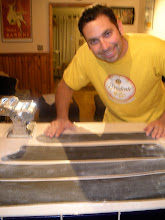Timothy O'Brien. About as non-Italian a name as you can get. Followed closely by Eric, Patrick and Allen, which just happen to be Tim's brothers' names. So, why pasta and ragù and not bangers and mash? Why a glass of wine and not a pint of beer? Why guanciale and pancetta and not corned beef and blood pudding?
In his 6th grade social studies class, Tim had to design his family tree. On one side he found a very proud English lineage, as far back as you could trace. On the other he found a hodge podge of Irish (O'Brien), German (Schlager), and even Swedish (Logren). The most predominant cultural influence, however, came from his paternal grandmother's branch of the tree - the Italian branch - which was the one most recently rooted in American soil. Marini, Capone, Cardarelli, Testa, Cappabianca - these names were the ones that attracted his interest and with which he was the most familiar.
Tim's grandmother, Viola Marini, is a first generation Italian-American, whose parents arrived in this country in the early part of the last century. Her father, Cesidio, never learned English. The household was about as Italian as you can get in Quincy, MA, and the food was no exception: they made their own wine; they drank goat's milk; they ate finocchio (fennel), rather than celery, stalks; and they made pasta and sauce from scratch every Sunday. Focusing primarily on the southern Italian cuisine of Campania, from where both Cesidio's and Filomena's families had come, Filomena taught her daughters - all five of them - to appreciate and cook in the old country's ways.
Tim grew up hearing Italian, especially words associated with food, thrown around in conversation. He grew up eating things no one in Maine had ever heard of: castagne (chestnuts) every Christmas; finocchio (fennel) with cream cheese and olives as an appetizer (it was only in the last couple of years that his now-wife informed him that "normal" people eat celery with cream cheese, not fennel with cream cheese); Auntie Ellie's biscotti, Grandma Viola's green (pistachio) cake and pizzelle, and Elsa's angelonies for dessert; and homemade red sauces with homemade meatballs. He grew up surrounded by people who ate their salad as a final course, drank sambuca and grappa as after-dinner aperitifs, and who never missed an opportunity for a family gathering.
So, when Tim's senior-year history project required him to focus on one aspect of his family's cultural history, he, of course, chose to study pasta. He'd seen his grandmother make it hundreds of times before. He'd watched her hang pasta to dry on the clothes drying rack every Sunday, just like her mother had done for decades. It was a no-brainer, really. He read every pasta book he could get his hands on, picked his grandmother's brain, borrowed her bastone (rolling pin), and set out to make fresh pasta. And how did it turn out? Horrible! Awful! Gummy, sticky, a glutenous mess. His mother asked him why there were worms in the water. He may have even ruined a pot. But he was hooked.
And today? Today's pasta is a far cry from that first disastrous experience. Frankly, we think it's delicious.
Sunday, November 15, 2009
Subscribe to:
Post Comments (Atom)

No comments:
Post a Comment